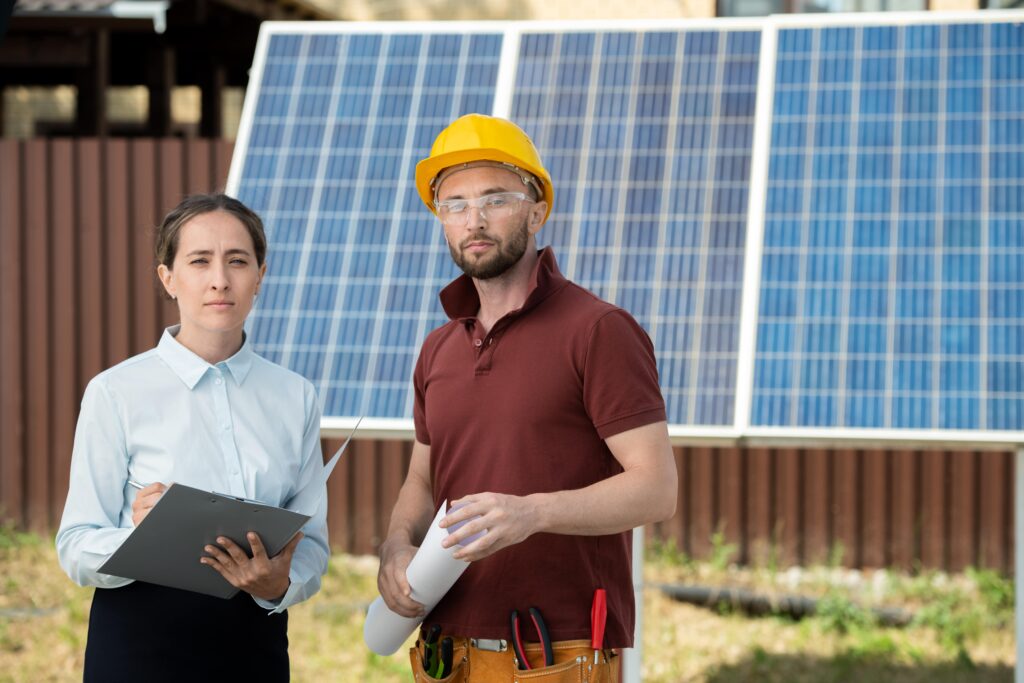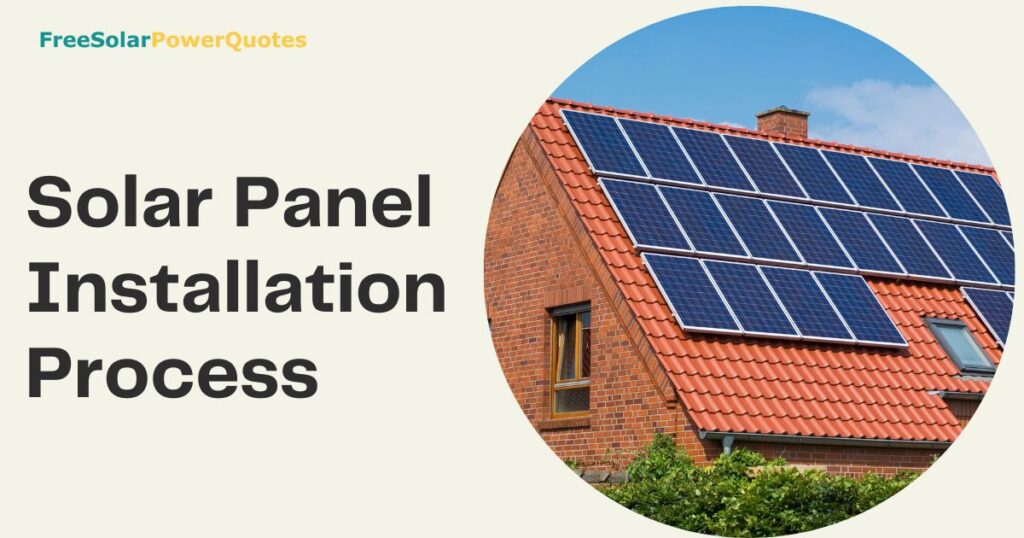Solar energy has recently become a popular renewable energy source. It is a clean and inexpensive alternative to traditional energy sources. Suppose you’re considering installing solar panels for your home or business. In that case, it’s important to understand the installation process to make informed decisions about the type and size of the system you want to install. This blog will take a step-by-step look at the solar panel installation process, covering everything from planning and preparation to the final commissioning.
Understanding Solar Panels
Let’s look at solar panels and how they function before we start the installation process. Solar panels generate DC electricity from photovoltaic (PV) cells. DC electricity must be converted to AC to power homes and businesses (AC).
Most solar panels are monocrystalline or polycrystalline. Monocrystalline solar panels are more productive than their polycrystalline counterparts because of their simpler crystal structure. However, they are also more expensive. On the other hand, polycrystalline panels are made from multiple crystal structures and are less expensive but less efficient.
Besides deciding between monocrystalline and polycrystalline panels, you must consider how many panels you need and what size they should be for your home or company. The efficiency of your solar panels will depend on several factors, including the amount of sunlight they receive and the angle at which they are installed.
Discover the solar panel that’s perfect for you – Explore our guide to learn about the various types at your fingertips!
Solar Panel Installation Guide
Steps to Installing Solar Panels
The solar panel installation process involves several key steps, including:
- Choosing the Right Location: When it comes to installing solar panels, location is key. A south-facing roof that receives plenty of sunlight is ideal, but if this isn’t an option, you can also consider installing panels on a ground-mounted system. It’s important to choose a location that provides the maximum sun exposure and to consider any shading from trees, buildings, or other structures.
- Assessing Energy Needs: Before installing solar panels, it’s important to assess your energy needs. This will help determine the size and number of panels needed to meet your energy requirements. Consider factors such as the amount of electricity you use, the orientation and slope of your roof, and the amount of shading on your property.
- Obtaining Necessary Permits and Approvals: Once you have assessed your energy needs and chosen the right location, you will need to obtain any necessary permits and approvals from your local government. Depending on where you live, this can be different, so be sure to check with your local building department for the rules in your area.
- Selecting a Professional Installer: Choosing a professional installer is an important step in the installation process. A professional installer will ensure that the panels are installed correctly and will also take care of all the necessary paperwork, including obtaining permits and connecting your panels to the electrical grid.
- Site Assessment and Preparation: Before the installation process begins, the installer will conduct a site assessment to determine the best location for the panels and make any necessary preparations, such as cleaning and repairing the roof. This is an important step that helps ensure the longevity and performance of the panels.
- Mounting and Wiring the Panels: Once the site has been prepared, the installer will begin mounting the panels to the roof or ground-mounted system. They will use a series of brackets and bolts to secure the panels in place and run electrical wiring from the panels to the inverter.
- Installing the Inverter: The inverter is the main component that converts the solar’s direct current electricity into alternating current, which may be used to power your home or company. The installer will install the inverter and connect it to the panels and the electrical grid.
- Commissioning and Testing: Once the installation process is complete, the installer will perform a commissioning and testing process to ensure that the system works correctly. This includes testing the panels, the inverter, and other components to ensure that the system generates electricity and provides the expected output.
- Ongoing Maintenance: After the installation process is complete, it’s important to regularly maintain your solar panels to ensure their longevity and performance. This may include cleaning the panels, checking the electrical connections, and monitoring the system’s performance to detect any issues early on.
By following these step-by-step solar panel installation processes, you can ensure that your process goes smoothly and that your system is installed correctly and efficiently.

Solar Panel Installation: Maintenance and Upkeep
A. Importance of Regular Maintenance:
Maintaining your solar panel system is important to ensure its longevity and performance. Neglecting maintenance can decrease energy efficiency and repair costs over time. Regular maintenance can also help prolong your solar panels’ life, helping you get the most out of your investment.
B. Maintenance Tips for Maximum Efficiency:
Here are a few tips for making sure your solar panel system works as well as it can through regular maintenance:
- Clean the panels regularly to remove any dirt, dust, or debris.
- Check electrical connections regularly to ensure they are functioning properly.
- Monitor the performance of your system by checking its output and comparing it to your energy usage.
- Schedule regular inspections with a professional to check the condition of your panels, electrical connections, and inverter.
- Sign up for a maintenance contract to ensure your panels receive the necessary care and attention.
C. Troubleshooting Common Problems:
The upkeep of solar panel systems is essential, but so is knowing what to do if something goes wrong. Among the most frequent problems are the following:
- Panel shading: Shadows cast by nearby trees or buildings can reduce the efficiency of your panels. You may need to trim trees or install additional panels to compensate if this is a problem.
- Poor electrical connections: If you notice a drop in performance, it could signify a loose or damaged electrical connection.
- Inverter issues: An inverter is an important component of a solar panel system, and its problems can impact performance. If you notice any issues with your inverter, it’s important to have it inspected by a professional.
Maintaining your solar panel system and being prepared for typical issues will keep it running efficiently for many years to come.
Power up your knowledge on the significance of solar energy – Check out our guide to discover why it’s become an essential part of our future!
Bottom Line
Installing a solar panel system is a great way to reduce your carbon footprint and generate clean, renewable energy. The process can seem daunting, but with the right knowledge and preparation, it can be a smooth and rewarding experience. From choosing the right panels and contractors to preparing your home and monitoring the performance of your system, the key to a successful installation is attention to detail. Regular maintenance and upkeep are also essential to ensure the longevity and performance of your solar panels. With proper care, your solar panel system can provide you with clean, renewable energy for years to come.
Don’t let high electricity bills hold you back – discover the savings of solar power with freesolarpowerquotes.com!
FAQS
What are the benefits of solar panel installation?
The benefits of solar panel installation include reducing your energy costs, decreasing your carbon footprint, and generating clean, renewable energy. Additionally, solar panels can increase your home’s value and provide energy independence.
What do I need to consider before installing solar panels?
Before installing solar panels, you should consider factors such as the orientation and slope of your roof, the amount of shading your roof receives, and your energy usage. You should also research different types of panels and contractors to ensure you get the best quality products and services for your needs.
How do I choose the right installer for my solar panels?
When choosing a contractor for your solar panel installation, look for a company with experience and expertise in the field. You should also ask for references and check their customer reviews and ratings. Be sure to get a detailed quote from several contractors to ensure you get the best value for your money.
What is involved in the solar panel installation process?
The solar panel installation process typically involves the following steps: site assessment, equipment selection, permitting and inspection, installation, and monitoring and maintenance.
How long does the installation of solar panels take?
The length of time it takes to install solar panels varies depending on the size of your system and other factors, such as weather conditions and the complexity of the installation. On average, a typical installation takes anywhere from 1-5 days to complete.
What are the maintenance requirements for solar panels?
While solar panels don’t require a lot of upkeep, it’s still vital to clean them and check for damage regularly. You should also have a professional inspect your panels and system every few years to ensure its functioning.
How can I tell if my solar panel system is working properly?
You can monitor the performance of your solar panel system by checking its output and comparing it to your energy usage. You can also use a monitoring system to track your panels’ performance and be alerted to any issues. If you notice any issues with your system, it’s important to have it inspected by a professional.

